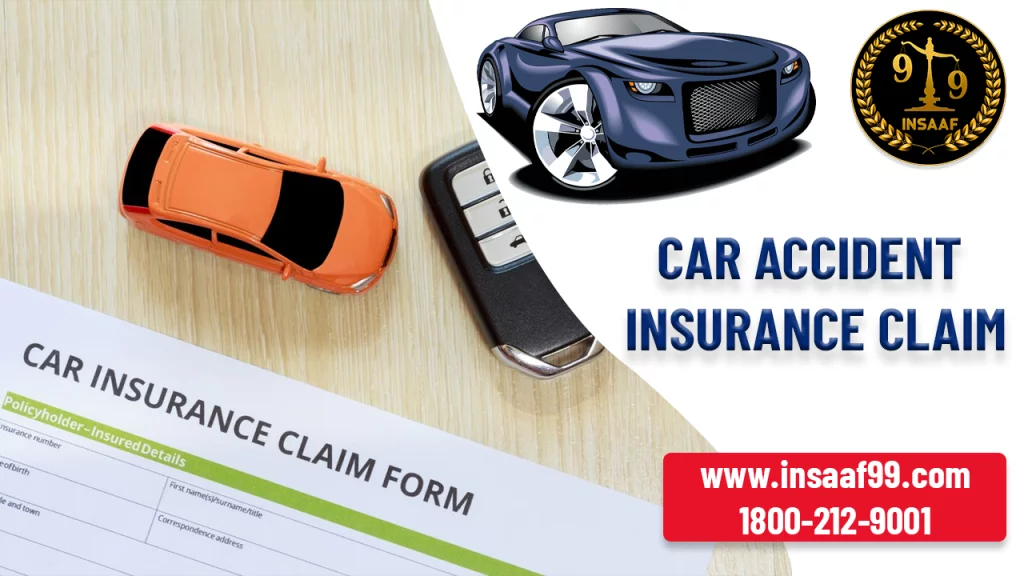

Online Legal Advice from Insaaf99® Online Lawyer Consultation in India


Online Legal Advice from Insaaf99® Online Lawyer Consultation in India

Life is full of unexpected twists and turns, and unfortunately, some of those unexpected moments can lead to a car accident. As drivers, we do our best to stay safe on the roads, but accidents can still happen due to a multitude of reasons. When such incidents occur, it is essential to know how to navigate the process of a car accident insurance claim.
Today, we will walk you through the entire process of a car accident insurance claim, step by step. From the immediate actions to take at the scene of the accident to dealing with insurance adjusters and negotiating settlements, we'll cover it all.
A car accident can be a traumatic experience, but with the right information and approach, you can safeguard your interests and achieve a favorable outcome. So, let's dive into this journey with us as we unravel the process of car accident insurance claims, guiding you toward a smoother path to recovery and resolution.
A car accident insurance claim is kind of a formal request which is made by the policyholder to the insurance company. It aims at receiving the financial compensation for covering the damages and any other loss caused due to the car accident. When an accident occurs, the involved parties may file a claim with their respective insurance companies, providing details of the incident and the damages incurred. The insurance company then investigates the claim and, if it is deemed valid and within the coverage provided by the policy, the insurer will pay out the appropriate amount to the policyholder to help them recover from the accident.
When it comes to car accident insurance claims, there are several different types, each serving a specific purpose and providing coverage for different aspects of an accident.
A liability claim is one of the most common types of car accident insurance claims. If you're at fault for causing the accident, your liability insurance will cover the damages and injuries suffered by the other party. This includes the cost of vehicle repairs, medical expenses, and sometimes even legal fees if the injured party decides to sue.
Collision insurance is designed to cover the cost of repairing or replacing your own vehicle in the event of an accident, regardless of who was at fault. If you collide with another vehicle or object, such as a tree or pole, collision coverage will help pay for the repairs or replacement of your car, up to the policy limit and subject to the deductible.
Comprehensive insurance, often referred to as "other than collision" coverage, protects your vehicle against damage not caused by a collision. This includes damages resulting from theft, vandalism, weather events (hail, floods, etc.), fire, falling objects, and collisions with animals. Like collision coverage, comprehensive coverage also has a deductible and a policy limit.
Personal Injury Protection (PIP) is a no-fault insurance coverage that varies by state. It provides coverage for medical expenses, lost wages, and other related costs for you and your passengers, regardless of who was responsible for the accident. PIP is particularly relevant in states with no-fault insurance laws.
If you're involved in an accident with a driver who has no insurance or insufficient coverage to compensate you adequately, uninsured/underinsured motorist coverage (UM/UIM) comes into play. This type of claim allows you to seek compensation from your own insurance company, up to the policy limits, for your injuries and damages.
The Medical Payment is an optional insurance coverage that you may appeal. It helps you to pay for the medical expenses resulting from a car accident. It does not matter as to who was at fault. It covers medical bills for you and your passengers up to the policy limit, and the process of filing a MedPay claim is usually straightforward.

The general steps involved in filing and processing a car accident insurance claim are as follows:
Immediately after the accident, prioritize safety. First of all, check for any kind of injuries and call for medical assistance as soon as possible in case it is needed. Move the vehicles to a safe location, if possible, to avoid further accidents.
Exchange contact information and other details like insurance and driver's license information with the other driver(s) if involved in the accident. Also, remember to collect contact information of any witnesses if present at the accident site.
Take photographs of the accident scene, the damage to the vehicles and any visible injuries. This evidence will really be beneficial for you in filing your insurance claim.
If there are injuries or significant property damage, contact the police to file an accident report. This report can serve as official documentation of the incident.
Always make sure to report the accident to your insurance company as early as possible. Many insurance companies have specific timeframes within which accidents must be reported for the claim to be valid. Provide accurate details of the accident and any injuries sustained.
The accident details will be need by your insurance company. Be prepared to provide details such as the date, time, and location of the accident, a description of how it happened, the names and contact information of all parties involved, and any relevant police report information.
Complete the necessary paperwork to file the insurance claim. This may involve filling out an online form, contacting your insurance agent, or visiting a local branch office.
Typically, an insurance adjuster is assigned the task to review and investigate the claim. The adjuster may contact you to gather more information and may also speak with witnesses and review any police reports or other evidence.
If your car is damaged, an appraiser or adjuster will assess the extent of the damage and provide an estimate for repairs. In some cases, you may be required to obtain repair estimates from approved repair shops.
If there are injuries involved, your insurance company may require a medical evaluation to assess the extent of the injuries and the necessary medical treatment.
After the investigation is complete, the insurance company will determine liability and coverage. They will offer a settlement based on their assessment of the damages and the terms of your policy.
If you agree with the settlement offer, you can proceed with the repair of your vehicle or seek medical treatment for injuries. The insurance company will then provide the agreed-upon payment, either to you or directly to the repair shop or medical provider.
Keep in mind that the timeline for the car accident insurance claim process can vary depending on the complexity of the accident, the extent of the damages, and the cooperation of all parties involved.
For More Information: - consultation lawyer online
Navigating the process of a car accident insurance claim can be a daunting and overwhelming experience, but armed with the right knowledge, you can confidently maneuver through the complexities and ensure your rights are protected.
In this blog, we have explored the various types of car accident insurance claims, from liability and collision to comprehensive and personal injury protection (PIP). Understanding these different types of coverage empowers you to make informed decisions about the protection you need on the road.
We've also delved into the step-by-step process of filing an insurance claim, emphasizing the importance of immediate actions at the accident scene, gathering evidence, and promptly reporting the incident to your insurance company.
Always remember that awareness, preparedness and the right information are your strongest allies on the journey to a fair and just resolution of a car accident insurance claim.
Drive safe, stay informed, and may your travels be filled with peace and security.